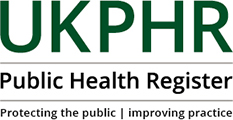Introducing the new public health apprenticeship: A potential route to registration for some
By David Kidney, UKPHR Chief Executive
Last year, the Institute for Apprenticeships and Technical Education (the Institute) published the approved standard for the new Level 6 Public Health Apprenticeship and earlier this month, Public Health England (PHE) published implementation guidance for employers and Universities.
Employers who pay the Apprenticeship Levy can spend their levy money on taking their employees through this apprenticeship, and the maximum public funding available for Universities delivering the apprenticeship will be £20,000 per apprentice.
The standard for the apprenticeship has been devised to match UKPHR’s standard for registering public health practitioners. In the run-up to the Institute’s approval of the new apprenticeship, we gave our approval of the apprenticeship standard and we committed to examine how apprentices could achieve registration with UKPHR as public health practitioners.
Our Board developed three options for giving effect to this commitment and towards the end of 2019 we consulted widely on these three options. We had very valuable feedback from a wide range of consultees. Responses were well argued, and all three options had good levels of support.
When the Board met on 18 February 2020, all the responses were considered, and the historic decision was taken to develop a second route to registration for public health practitioners based on successful completion of the apprenticeship. The Board asked our Education & Training Committee to lead for UKPHR on the design of the new route: the scheme, the process and guidance for applicants.
The Education & Training Committee met on 07 April and accepted this task and decided how the Committee will approach its work. A crucial concern for the Committee was that local scheme coordinators and UKPHR’s team of Moderators should be involved in the design of the new route from the beginning. In due course, the Committee will deliver its recommendations to the Board and the latter has already committed to further consultation on the design of the route before it is implemented.
The Committee has started its work and expects to be in a position to report on progress by Autumn 2020. It is noted that no University has yet unveiled a course offering the apprenticeship and it is anticipated that apprentices will take approximately three years to complete the apprenticeship. Nevertheless, the Committee wishes to put the new route in place sooner rather than later so that all interested parties will have sight of the professional requirements for achieving registration by the new route.
The apprenticeship is described as “Integrated” because all the requirements must be met, including a satisfactory End Point Assessment (EPA), before a certificate of satisfactory completion can be obtained. Hence, the degree must be achieved, and the employer must sign a statement confirming that the apprentice meets the gateway requirements and is ready to undertake the EPA. Following this, the rigorous requirements of the EPA must be met and passes must be achieved in the extended presentation of practice and the additional five scenario-based Situational Judgement Tests.
UKPHR has an interest in the quality of the assessments that will be made in the EPA. At the very least, we will want to have sight of who the assessors are and how they have been trained for their assessment work. The Institute’s standard states that the assessors must be independent of the apprentice, the employer and the training provider (usually I expect this to be a University). This is to ensure that there will be no conflict of interest.
The Institute’s standard requires EPA Organisations to provide training and CPD to the independent assessors they employ to undertake the EPA.
UKPHR has similar requirements for the assessors who assess practitioners’ portfolios under our current route to registration for public health practitioners. It would be helpful if we could join forces with the Universities and EPA Organisations to align our and their recruitment, training and development of assessors. If we can co-operate, we may achieve a win-win situation where our assessors of portfolios may also assess for them at EPAs and vice versa (their assessors may assess portfolios for us).
I think this is an exciting time in the development of practitioner registration in the UK. But equally, it is a challenging time as UKPHR’s Board is determined that when there are two routes to registration for public health practitioners, both will be fit for purpose and robust. We never lose sight of the purpose of registration – we see registration as an assurance of the competence of all practitioner registrants to practise public health autonomously – which is first and foremost public protection.
I would be delighted to receive your feedback at register@ukphr.org




Comments are closed.